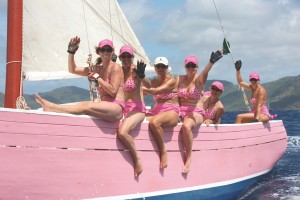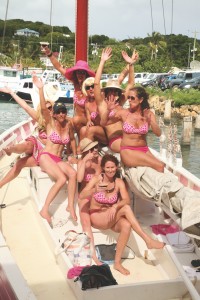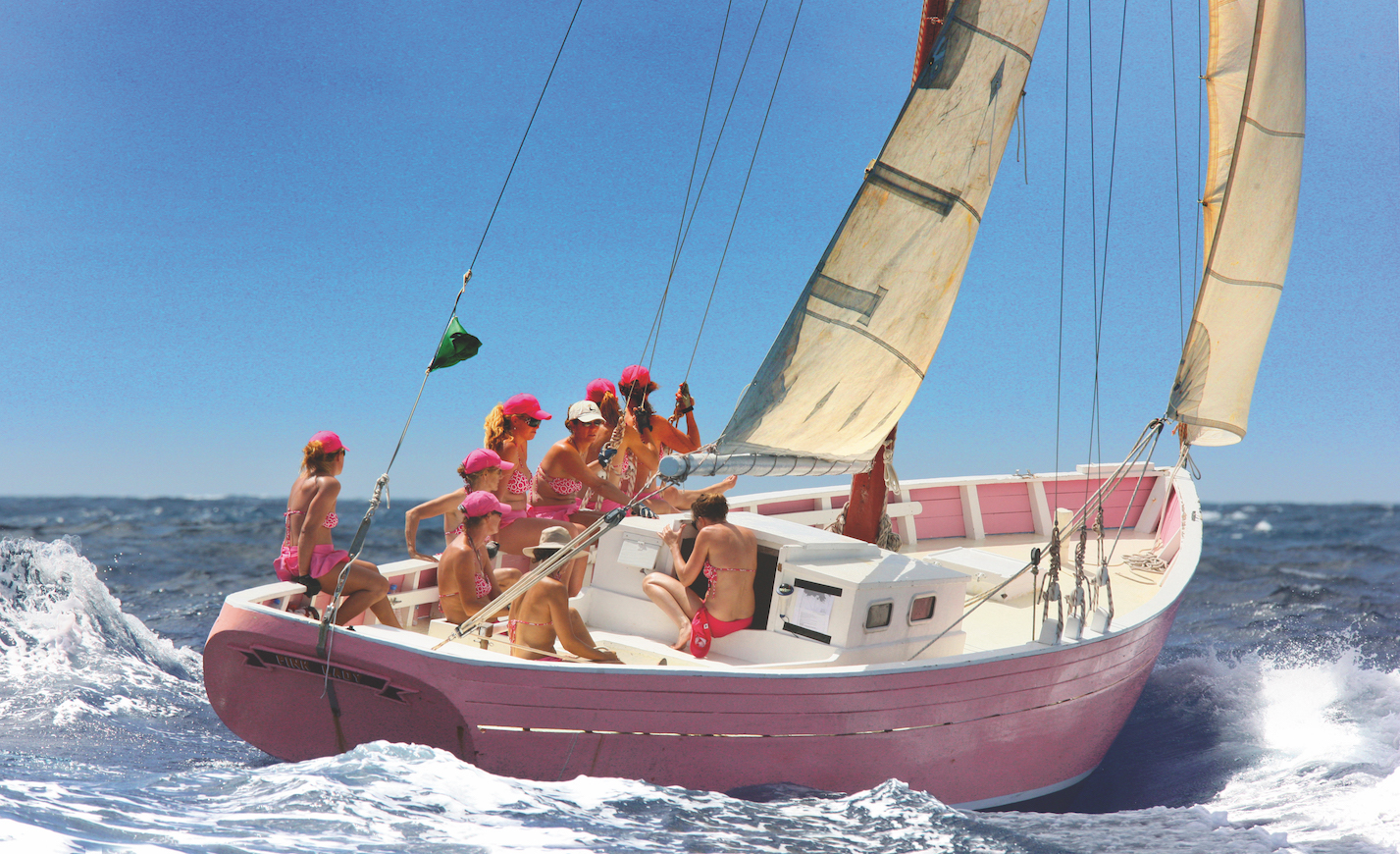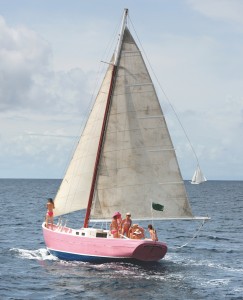The Antigua Classics started today, and the 31-year-old event is going as strong as ever. It holds an almost mythical place in many a sailor’s heart, with the fantastic tradewind sailing in crystal cobalt seas mixed with some rum punch and a great party atmosphere down-island style.
The event attracts its fair share of characters – from salty types who make it look like they were just sailing through to those who have made a deep-water pilgrimage to the place. One of the more unusual entrants (back in 2010) was a pink island boat with an equally pink crew – all female, who stole the show so much that they are still being mentioned in the programme!
So for all those who are there in spirit, if not in person, here is the story of skipper Kirsty Morrison who dreamed in pink… and then made it happen.
The 2010 Antigua Classics were over; my boat and body were recovering and I was still wondering quite how all of this came about. For me this regatta was a realisation of a three-year dream. I had brought Pink Lady, a 37ft (11.3m) Carriacou sloop 300 miles from Carriacou and raced her in the 2010 Antigua Classics regatta with some of my most inspiring female sailor friends, all clad in pink bikinis.

With all that hot pink; sunglasses were needed. LR: Killer Bee/Belinda Jones, Psycho Betty/Marcy Finnas, Scary Mary/Mary Stoof, Mamasan/Joanne Spinks, Heiny/Jan Hein, Baywatch Babe/Katherine Tacon (Tim Wright: photoaction.com)
Built in 1975 on the beach in Windward, Carriacou, she is the oldest sloop still afloat and the only one to compete in Antigua without winches. It took three of my girls hanging off the jib sheet to trim for the upwind legs and even more suspended from the main halyard to tighten the luff.
Between the two world wars as many as 130 trading sloops and schooners were built down in these Grenadine islands. After the abolition of slavery Scottish shipwrights had been brought to Carriacou to build vessels for the landowners so their produce could be transported to sell in Grenada. The roots of their design are still shrouded in mystery, but a combination of the need for smuggling vessels able to move out of territorial waters quickly and speedy fishing boats to bring their catch home first resulted in these elegant racing lines. The boats are rough and ready; every- thing is crafted by hand. The West Indian Cedar frames are locally grown and the masts are often found in the forests of Grenada. Ballast is usually lead rock spread about the bilges or sometimes bags filled with sand or water. These boats throw up as much canvas as they possibly can. Often rigged with running backstays, their booms overhang the sterns by several feet. They don gaffs or vertical sprits, bowsprits, staysails, asymmetrical spinnakers and even ‘water sails’ which hang below the boom when running downwind.
Pink Lady was built by Ellis MacLaerens, an 86-year-old shipwright who is still very much alive in the town of Windward. In those days she was called Super Mac and a friend of mine remembers working on her in his youth when she was run as a fishing boat. Ten years ago she was bought by Robert Barrett, owner of the Palm Island resort, painted pink and renamed. She was run as a day charter boat for guests from the resort. Consequently her rig was reduced to lessen the heeling and the ensuing squeals of the tourists. For the last two years, she has sat prettily but sadly on her mooring ball off the golden sands of Palm Island, unused and unloved.
I first spotted her while running a charter out of my home at Bequia. I had always dreamed of building one of these sloops and painting her pink and taking her to Antigua Classics with a female crew in pink bikinis. To my disbelief, here she was, she already existed. No need to build, I just had to get my hands on her. Well, after two years of fruitless negotiations with Mr Barrett I played my trump card and told him my dream of the pink bikinis. This seemed to awaken his interest and early in 2010 I finally received a call begrudgingly telling me “you can take the boat”. The deal was that he would cover all costs but I had to make it happen.
I flew down to Palm Island the next day to assess the situation and begin the overwhelming task of getting this baby to Antigua in a ridiculously short time. She had no engine and rotten sails, her deck planking was split from months of baking in the tropical sun with no salt water to keep them moist, the bilges were full, the rigging was frayed. The only things on board were an anchor and a child-sized fender. I could never bring myself to throw that little fender out and it doubled as a perfect pillow on the delivery north!
Haul-out
We towed her down to Carriacou and hauled her out at Tyrrel Bay. Ellis’s son came down and caulked the bottom and the deck planks. We repainted the bottom and deck, replaced the rigging, the lines, cleats, and blocks.
After too many days of working in the hot dusty yard, one Sunday I granted myself a break and set off on a personal pilgrimage to the town of Windward. Once I mentioned Pink Lady I was greeted like family. I was given a tour of the three sloops currently being built on the beach – one in the traditional style and two in the new ‘racing style’ with vertical bows, shallower hulls and wider beams to increase waterline and reduce heeling. These Windward boys are passionate about building for speed. Although some still fish, they now seem to be building solely for the honour of creating the fastest boat. Started in 1965, the Carriacou regatta has become one of the biggest festivals in the area. There are cash prizes and the competition is fierce.
A week before Easter, Pink Lady was finally ready to sail up to Bequia. The day we splashed it rained the first drops in months. “The rain blessin’ Pink Lady,” the local boys told me. I had a sleepless night before I embarked on my first passage with this old girl with shot sails and no engine as back up. The weather was terrible with high winds and the largest seas of the winter, but she took them like a lady and the sail just about held out.
Although this shakedown instilled some confidence in the seaworthiness of the hull I was still nervous about the sails, especially given the lack of engine. I managed to find some old sails a friend, Fixman, had inherited when he bought his boat, Tjeldjoy. After a day of dragging them out of his bilges and measuring for the most suitable size I took an oil-stained, but markedly less rotten, piece of canvas to my friend Allik the sailmaker. He was bubbling with excitement at the prospect of creating something to make this little local boat go faster.
He told me his philosophy of sail design – you had to balance the sails so that you could let go of the tiller for long enough to light a joint! We gave the sail as much roach as we could with the fixed backstay – I contemplated running backstays but this just seemed to be adding to my ever growing list and time was running out.
Two days later Mr Barrett called – he was flying a new engine to St Vincent. He cleared it through customs in half a day and had it installed over the Easter weekend. Suddenly things had changed. Now we could island hop and maybe avoid sailing this instrument-free vessel by night.
One of my Pink Ladies, Christine Mattson, flew down from Tortola and two of my favourite Bequia boys, Noel and Iba, joined us for the delivery to Antigua. As it had been all along, time was tight. We were not ready to leave on the Thursday and Saturday was cutting it too short. So we took the plunge, threw gifts to Neptune, and started this voyage at dawn on a Friday.
A friend of mine left a few hours earlier in a significantly faster boat. We crossed the Bequia channel without incident and it felt great to be finally on the way. Then as we motored along the lee of St Vincent, I received a text – “f***ing horrible north of St Vincent”. I was unperturbed. She had already proved her seaworthiness and now we had new sails, and after all wasn’t it always horrible north of St Vincent?
We soon learnt he wasn’t exaggerating. We encountered some of the worst seas I have ever seen in the Caribbean: 20ft walls of water bearing down on us with at least 30 knots of wind howling by. Again she took it well, but I was nervous as I scanned the horizon and saw constantly grey skies with no indication that this was a passing squall. It seemed like a (totally unforecast) system that was set to stay. After two hours of hammering I made the call to turn back. I saw an even greater density of white caps ahead; this was only going to get worse.
We limped into Cumberland Bay cold, wet and despondent. We ran into friends who said they had been hammered all the way up from Grenada in their 60ft (18.3m) cat. The forecast, it seemed, was the same for the next four days. We had paid for leaving on a Friday and I seriously doubted we were going to get to Antigua in time for the Classics. I couldn’t believe it was all falling apart so quickly.
After a restless night on a mattress on a floor in an empty house in St Vincent we figured we would go and poke our nose out into the channel and see what it held. I couldn’t imagine that those seas had lain down in less than 12 hours, but at least we could go and look.
The crew fell silent as we came out of the lee and into the channel, waiting for the seas to build and the dream to all be over. But nothing happened. The seas were flat, we couldn’t believe it was the same water.
It was so calm that we decided to crank up the engine. I turned the key, the engine started, put her into gear. No prop. I went forward-neutral-reverse a few times, and still nothing, the prop was not turning.
Disconnected!
I climbed down below and shimmied myself alongside the engine. Immediately our problem glared at me: there was about a foot of air between the engine coupling; the shaft was no longer connected. There was still enough breeze to sail so we decided to keep going and see if we could fix it along the way. We found all four bolts in the bilges, although one was sheared. We retrieved the nuts and managed to put the coupling back together. Every hour we stopped the engine and tightened the bolts, then we noticed that the mountings were loose and misaligned and there was a steady stream of water pouring out of the stuffing box. We limped in the cold, dark, pouring rain into Rodney Bay, St Lucia, again wondering if this was ever going to happen.
A friend came and picked us up, cooked us a hot dinner, gave us a hot shower and put us to bed in 1000 count linen. In the morning I scoured the docks for friends and family I knew were here. It was Sunday so I would have to rely on them for the parts I needed. I found a new bolt for the coupling, two locking nuts and two locking washers. I borrowed wrenches to keep the stuffing box tightened and two jerry jugs to fill with diesel. Our only option now was to head straight up without stopping.
By lunchtime we were off. A friend of mine, Allan, left with us and promised to shadow us in case of any more mishaps. This was our saviour as it meant we could sail straight through to Antigua and still make it in time. Three humpback whales crossed our bow as we left Rodney Bay and immediately the atmosphere changed, we finally felt there was a chance we would make it.
We crossed the channel to Martinique in magnificent style. On a beam reach, hitting 8 knots more than once, Allik had done his job, we hardly touched the tiller! A night passage to Dominica went without incident until suddenly the headsail started to flog and I realised we had lost our halyard. We motored into Portsmouth early that morning wondering how we were going to get someone up the mast on our winchless boat. Then we realised we had a winch – Noel hand-pulled Iba up the mast and the halyard was re-threaded. After that it was ‘plain sailing’ – only one more island to go.
We sailed with a gentle breeze, that evening, through the lee of Guadeloupe. The sun was setting to the west and a rain squall over the land produced a glowing rainbow to the east, Chris and I stood on the foredeck and didn’t know which way to look. As I fantasised that this moment really deserved a cold beer Allan hailed us on the VHF and announced they were coming alongside to deliver that very thing.
We raced across the final channel to Antigua that night, dropping the hook off Pigeon Beach at the mouth of Falmouth Harbor at 4am Tuesday. We had hardly slept for two nights, had no hot food, few cold drinks, used a bucket as a head and dozed on top of the old mainsail. With no radar, only battery operated running lights, a handheld GPS and a headlamp taped above the compass we had made it against the odds. Exhausted but with adrenalin pumping we drank rum until dawn and slept the sleep of the dead until midday.
We awoke with fuzzy heads to an equally fuzzy horizon. It was a day of constant rain, much needed in drought-ridden Antigua. Perhaps Pink Lady was the rain boat after all. A text from a friend confirmed this. “I see you off Pigeon Beach, congratulations and thanks for bringing the rain!” We took her into the dock stern-to with an eager crowd of spectators, friends from near and far, waiting to greet us and buy us more rum.
We had one final hurdle to cross. The boat having never left the Grenadines was not registered. I was nervous about how Immigration would deal with this. They didn’t know how to react. They had never come across this before, they said. After words with his boss the officer returned with our form and under ‘Registration number’ wrote ‘00000’. We were official!
Goosebumps
We checked into the St James’ Club, which Robert Barrett also owns and wonderfully was putting us all up in. My crew flew in over the next few days and by Friday we were ready to go racing. We knew we didn’t stand much of a chance with only two sails and a main half the size of everyone else’s. The first day we came in last but were greeted by three horns from the committee boat and a “Girls girls girls welcome home!” I had goosebumps as we crossed the line and several people remarked later that they had never heard of a committee boat give a gun to a boat coming in last.
Although most of the girls had not met before the crew bonded instantly and soon were putting on quite a show. I had brought 75 Pink Lady hats along and soon people were wanting to buy them. The dock was always awash with photographers as I came in with that nasty stern-to docking. Boats hooted us as we left and re-entered the harbour and I lost count of the number of people who said we had made the regatta. Pink Lady was the boat to party on after racing. There were friends, photographers, journalists, now we knew what it was like to be famous! I was still pinching myself and couldn’t quite believe we were actually here.

Celebrating their success. The girls in pink had made their mark on the water and ashore. By Den Philips
Day Two saw more wind and it was our day. We had resigned ourselves to a consistent last place and were beginning to lose our competitive edge when, on the windward leg, on opposing tacks, I suddenly realised we were passing in front of Alexander Hamilton, a Nevis schooner who had to give us time. We couldn’t believe it and suddenly the girls were back to full trimming action, especially when we saw the same happen with another Carriacou sloop, Good Expectations. We were sailing right through them as they all heeled, overpowered by the 20-25 knots of wind with their huge overhanging mainsails. That day we got a real gun, third across the line, and I was ecstatic that we had proven ourselves as more than just the party boat.
By the end of the regatta we had firmly established ourselves as a highlight. Through improvisation and lots of last- minute planning we had managed to come up with different outfits every day and decorate the boat with pink balloons on the final day. I could not have asked for a better group of girls to help me live my dream. At the awards ceremony they created a new prize especially for us: “Most attractive and most enthusiastic crew”. Next year I hope to persuade Mr Barrett to let me do some work on increasing our rig as we want to be collecting trophies!
Main photo: Tim Wright: photoaction.com








